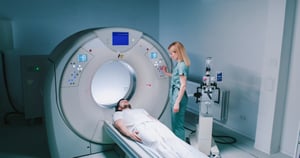
VALUE MEASUREMENT VS. FMRI
Functional Magnetic Resonance Imaging (fMRI) measures changes in the oxygenation of blood in the brain to determine which regions are most active during an experience.
WHAT IS FUNCTIONAL MAGNETIC RESONANCE (FMRI)?
fMRI is a technique used often in neuroscience, but less popular in neuromarketing. An fMRI is a scan that uses a strong magnetic field and radio waves to create a 3D image of brain activity. To conduct an fMRI study, a participant lies on a bed that is retracted into a large metal tube where an algorithm is used to measure changes in the brain's magnetic field. fMRI is commonly used in academic research, but in neuromarketing, it's not as common as it is very costly, slow and complicated.
fMRI is an effective way to identify the locations of small changes in brain activity. However, it is thought to have poor reliability and is subject to over-interpretation because of the large amount of data collected. fMRI is not optimized to predict behavior but is focused on identifying the most active areas in the brain during a certain task.
Since MRI machines are very bulky and exceptionally expensive to maintain3, measurement can only be conducted in a laboratory setting by individuals who have been extensively trained in the technology and in working with the data. Researchers can typically only collect data from one individual at a time, and some people report feeling claustrophobic while inside the MRI tube.
As a result of these complexities, it typically takes months to execute and get insights from a project employing this methodology. Additionally, fMRI lacks in the extreme ecological validity so it is very difficult to cheaply and easily scale to wide audiences.
3 Vul, E., Harris, C., Winkielman, P., & Pashler, H. (2009). Voodoo correlations in social neuroscience. Perspectives on psychological Science, 4(3), 274-290.
THE BENEFIT
fMRI is widely recognized in neuroscience and considered a fairly reliable measure of neural activity.
fMRI scans offer images with more detail than other diagnostic imaging techniques.
THE DRAWBACK
fMRI requires access to costly equipment, lab time, and trained professionals to measure and interpret the data.
fMRI requires that study participants are in the lab in an enclosed metal tube, which detracts from the experience, and many individuals report feelings of claustrophobia, meaning their reactions are likely unnatural.
fMRI data takes months to process and requires professionals to interpret data to identify actionable insights, if any.
Since you can only measure one individual at a time, fMRI measurements are not easily scaled to wide audiences.

DINNER PARTY FACT FOR BRAIN NERDS:
An fMRI scan uses a very large magnet to cause the electrons in brain cells to spin in the same direction. A radio frequency pulse then changes the direction of spin temporarily and the return to the axis of the magnet varies for oxygenated and de-oxygenated blood.
(Isn't science WILD?)
HOW VALUE MEASUREMENT IS DIFFERENT
Value Measurement does not require large equipment to scan the brain. It is scalable to huge audiences simultaneously and allows the capture of natural reactions in natural environments, using the smartwatches people already own.
Value Measurement measures the impact of any experience by detecting subtle heart rhythm changes that signal the brain is getting value and releasing key neurochemicals significant to future recall and action. As a result, you have insight into what connected most, and what fell short for your audience.
IS IT A VALUE MEASUREMENT?
FEELS LIKE IT'S PURE MAGIC BECAUSE IT'S GOOD SCIENCE
Your brain tells a story. Your smart watch is ready to listen. After more than 20 years of published, peer-reviewed research, we’re connecting the two. Now, using everyday wearable devices to capture activity within the body, we can measure the brain's value throughout the day.
Don't take our word for it. Download the full scientific and academic background.

